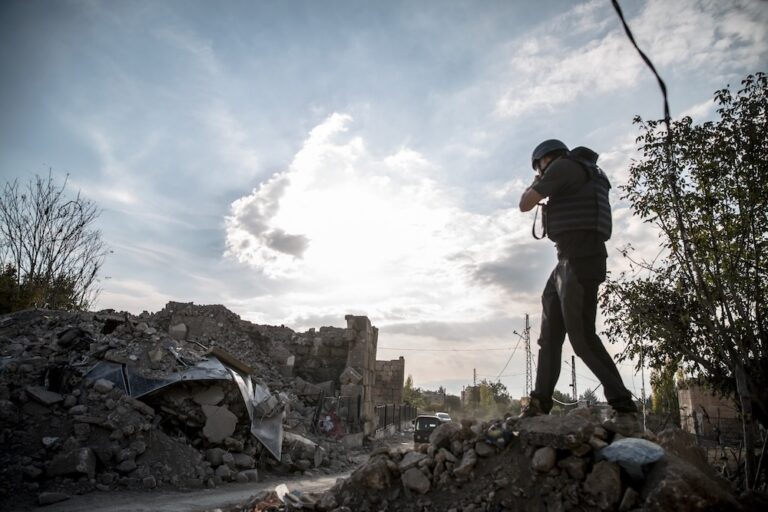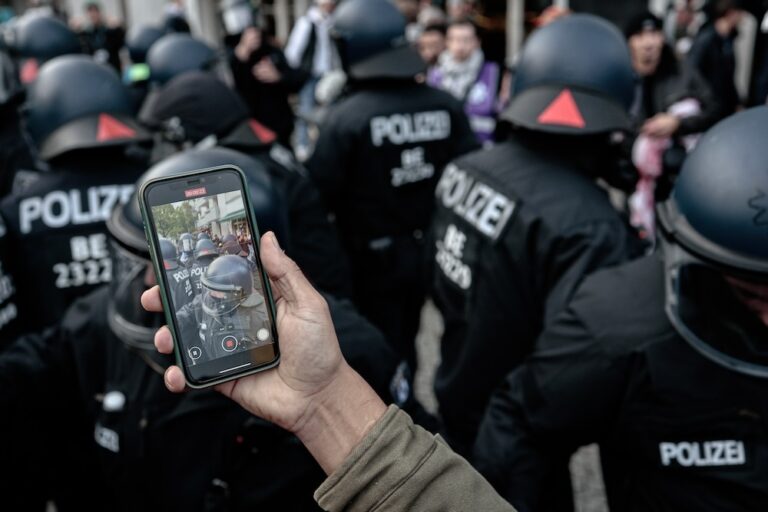(RSF/IFEX) – Since 29 September 2000, RSF has recorded thirty journalists shot (some were shot several times) in the Occupied Territories. With one exception, there is little doubt that the gunshots were fired from Israeli positions. In addition, on the occasion of Ariel Sharon’s visit to France on 5 and 6 July 2001, RSF has […]
(RSF/IFEX) – Since 29 September 2000, RSF has recorded thirty journalists shot (some were shot several times) in the Occupied Territories. With one exception, there is little doubt that the gunshots were fired from Israeli positions. In addition, on the occasion of Ariel Sharon’s visit to France on 5 and 6 July 2001, RSF has relayed to the French authorities its grave concern for the safety of journalists covering the “Second Intifada”.
“It is certainly lucky that none of the many journalists covering this conflict have been killed to date,” stated Robert Ménard, the organisation’s secretary-general. “The Israeli authorities must immediately launch transparent and impartial investigations into each of these incidents and make the results public,” insisted the organisation, adding that the Israeli Armed Forces should also introduce emergency measures to guarantee the safety of journalists in the conflict zone.
RSF has asked the French authorities, particularly President Jacques Chirac and Prime Minister Lionel Jospin, to raise this issue with Israeli Prime Minister Sharon during his visit to Paris.
RSF recalled that of the 30 injured journalists, 21 were Palestinian, two were American and seven were French. The French journalists included Luc Delahaye, photographer from the Magnum agency (shot twice), Patrick Baz, photographer from Agence France-Presse, Jean-Marie Bourget, journalist from “Paris-Match”, Bruno Stéphens, free-lance photographer working for “Libération”, Laurent Rebours, correspondent from the Associated Press (AP) agency, Laurent Van der Stockt, photographer from the Gamma agency, and Bertrand Aguirre, TF1 correspondent in Jerusalem. Aguirre’s bullet-proof vest saved his life.
Though it is impossible to confirm that all these journalists were deliberately targeted by Tsahal soldiers, it is beyond a doubt that, being mostly cameramen and photographers, they were clearly identifiable by Israeli forces. This invalidates the authorities’ explanation that journalists expose themselves to gunshots by mingling with demonstrators during confrontations. This is notably the case with Palestinian journalist Laila Odeh from Abou Dhabi TV, who was injured on 20 April in Rafah, in the Gaza Strip, where no confrontation was reported at the time. The same is true of Aguirre, who was shot by an Israeli border guard on 15 May in Ramallah, after confrontations had ended.
The most serious injuries to journalists resulted from live-bullet shots. In at least five cases, the journalists narrowly escaped death. The injuries suffered by two journalists will likely affect them for the rest of their lives. Yola Monakhov, from the AP agency, who was seriously wounded in the lower abdomen area on 11 November, will suffer lifetime after-affects. The left leg of Van der Stockt, from Gamma, is still paralysed five months after his injury. He was wounded in the knee on 9 February. In six to eight months, he should know whether he will ever walk again normally.
With a few exceptions, no investigations were opened into these incidents. This is all the more true in cases involving Palestinian journalists. When investigations are launched, under international pressure, their results are not made public. To this day, we do not know if those who fired the gunshots or their superiors were punished.


